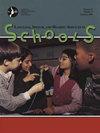Exploring Explicit Intervention to Target Grammatical Forms With Spanish-English Bilingual Children With Developmental Language Disorder.
IF 2.9
3区 医学
Q1 AUDIOLOGY & SPEECH-LANGUAGE PATHOLOGY
Language Speech and Hearing Services in Schools
Pub Date : 2025-07-02
DOI:10.1044/2025_lshss-24-00132
引用次数: 0
Abstract
INTRODUCTION Speech-language pathologists have limited evidence-based methods for grammar intervention to use with multilingual children with developmental language disorder (DLD). Explicit grammatical intervention is a promising approach for this population and has the potential to facilitate cross-linguistic transfer to an untreated language. In this clinical focus article, we present steps for implementing a grammatical language intervention for bilingual children that integrates explicit connections between a child's languages and examine evidence of a treatment effect. METHOD Three 4- to 8-year-old Spanish-English speaking children with DLD participated in a single-subject nonconcurrent multiple-baseline design study. The participants received an explicit-based grammatical intervention in English, adapted to promote cross-linguistic transfer to Spanish, targeting regular past tense and present tense forms. We describe how each step in the intervention could be adapted and implemented by monolingual clinicians. RESULTS Participants showed preliminary evidence of a positive treatment effect on English -ed and -s, with varying degrees of transfer to corresponding Spanish grammatical measures. CONCLUSIONS This is the first investigation of an explicit-based grammatical language treatment involving Spanish-English bilingual children with DLD. With careful design and planning, this approach has the potential for providing benefits in the child's untreated first language by drawing on metalinguistic strengths and cross-linguistic similarities.探索对发育性语言障碍的西英双语儿童目标语法形式的显性干预。
语言病理学家有有限的基于证据的语法干预方法用于多语种儿童发育性语言障碍(DLD)。明确的语法干预对这一人群来说是一种很有前途的方法,并且有可能促进跨语言迁移到未经处理的语言。在这篇临床重点文章中,我们介绍了对双语儿童实施语法语言干预的步骤,该干预整合了儿童语言之间的明确联系,并检查了治疗效果的证据。方法3名4 ~ 8岁的西班牙语-英语儿童参加了一项单受试者非并发多基线设计研究。参与者接受了明确的英语语法干预,以促进西班牙语的跨语言迁移,目标是规则的过去时和现在时形式。我们描述了干预的每一步如何被单语临床医生适应和实施。结果实验对象对英语-ed和-s表现出积极的治疗效果,并有不同程度的转移到相应的西班牙语语法措施。结论:本研究首次对西英双语儿童DLD进行显性语法语言治疗。经过仔细的设计和规划,这种方法有可能通过利用元语言优势和跨语言相似性,为儿童未经处理的第一语言提供好处。
本文章由计算机程序翻译,如有差异,请以英文原文为准。
求助全文
约1分钟内获得全文
求助全文
来源期刊

Language Speech and Hearing Services in Schools
Social Sciences-Linguistics and Language
CiteScore
4.40
自引率
12.50%
发文量
165
期刊介绍:
Mission: LSHSS publishes peer-reviewed research and other scholarly articles pertaining to the practice of audiology and speech-language pathology in the schools, focusing on children and adolescents. The journal is an international outlet for clinical research and is designed to promote development and analysis of approaches concerning the delivery of services to the school-aged population. LSHSS seeks to advance evidence-based practice by disseminating the results of new studies as well as providing a forum for critical reviews and meta-analyses of previously published work.
Scope: The broad field of audiology and speech-language pathology as practiced in schools, including aural rehabilitation; augmentative and alternative communication; childhood apraxia of speech; classroom acoustics; cognitive impairment; craniofacial disorders; fluency disorders; hearing-assistive technology; language disorders; literacy disorders including reading, writing, and spelling; motor speech disorders; speech sound disorders; swallowing, dysphagia, and feeding disorders; voice disorders.
 求助内容:
求助内容: 应助结果提醒方式:
应助结果提醒方式:


